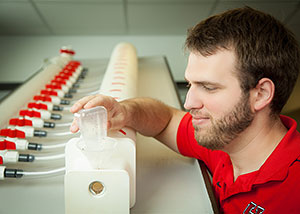UH Biology Ph.D. Student Receives NSF Doctoral Dissertation Improvement Grant
Research Serves as Model for Studying Degree and Speed of Adaptation to New Environments

Drew Russey, biology Ph.D. student, releases fruit flies into a wind tunnel. Experiments are shedding light on the degree and speed of adaptation to new environments.William “Drew” Russey, a University of Houston Ph.D. student in biology, received a two-year, $15,000 National Science Foundation Doctoral Dissertation Improvement Grant (DDIG). The grant supports his research on fruit flies and their ability to adapt to new environments.
The DDIG, a highly competitive NSF award, provides partial support to doctoral candidates, giving them additional funds for use in expanding their research or conducting research in specialized settings. Russey’s advisor is Tony Frankino, UH assistant professor of biology.
“Many species of flies from cool areas (high latitudes or high elevations) are genetically predisposed to be larger, with disproportionately large wings when compared to flies from warmer areas,” said Russey. “Flies raised in the lab at cool or warm temperatures develop structural features that mimic flies from cool or warm geographic regions.”
Adaptation to Changing Environments
Russey’s study of fruit flies will shed light on the degree and speed with which organisms can adapt to different or changing environments. The project uses a variety of approaches to determine if, and how, variation in relative wing size affects flight performance, and ultimately reproductive success, in different thermal environments.
“Flies are good biological models for the study of adaptation because we can raise them in the lab in large numbers and for many generations,” said Russey, who is a fifth-year Ph.D. student. “We also can easily measure their structural features and flight performance and watch them evolve in response to selection in real time.”
Flies are also good models for human genetics. “Their physiological adaptation to new temperatures or to a more demanding existence may offer insights into the genetics of health and aging,” he said.
Fruit Fly-Sized Wind Tunnel for Flight Tests
The experiments use a fruit fly-sized wind tunnel manufactured at the College of Natural Sciences and Mathematics’ 3D print facility. After rearing groups of flies at a moderate temperature, Russey tests their flight skills at either 61 or 80 degrees Fahrenheit.
“The strongest fliers make it farthest up the tunnel, and I select the top 15% of flies in each generation and use them to foster the next generation,” he said. “I’m predicting that the flies selected at the cooler temperature will evolve morphologies (or structural features) that are similar to flies that live in naturally occurring cool temperatures.” In turn, Russey expects the flies selected from the warmer temperature to evolve in ways similar to flies from warmer regions.
The 3D printing technology used to make the tunnel represents a new and rapid way of developing scientific instrumentation. Recent UH graduate Christine Sikes, Frankino, and engineering faculty member, Stan Kleis, designed the wind tunnel. Russey will use the DDIG funds to construct a second tunnel for use in house or on the road to test flight performance at different elevations.
Mentor to Undergraduates
Mentoring undergraduates is also an important part of Russey’s research, and he makes sure the students in his lab have opportunities to present their work in public forums.
“The hands-on experience of conducting experiments, examining the results, and presenting findings to others helps students develop a deeper understanding of a topic that you simply can’t get from less immersive experiences,” Russey said.
After he completes his Ph.D., Russey plans to pursue a career in academia.
- Kathy Major, College of Natural Sciences and Mathematics